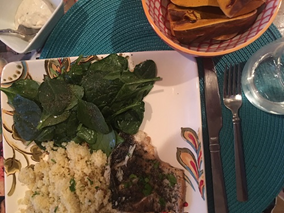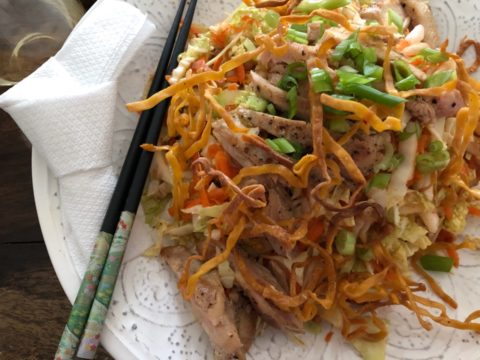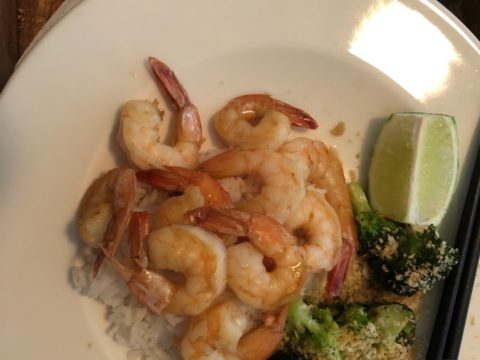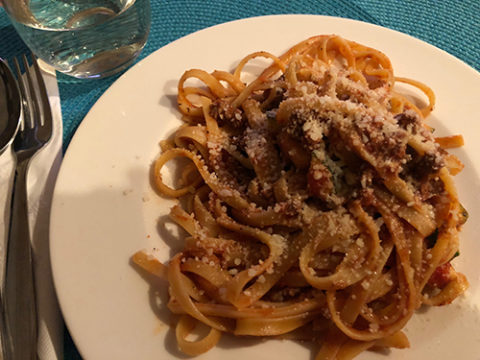Barramundi & Herbed Couscous

Italian Sausage Pasta Soup
November 18, 2017
Blue Apron Version

My Version
As Sent:
Hackability:
I just got my first Blue Apron delivery yesterday, and I have to admit I was pretty psyched. I ordered Asian beef buns, grilled cheese with apple, and the one I was most looking forward to, barramundi with couscous. I love barramundi, and I once caught one in the Murray River in South Australia, so that dish resonated with me. Of course, that was my first choice to dive into my Blue Apron experience.
The dish all together is pan seared barramundi, with a sauce and three sides. The sauce is a dukkah spiced labneh, and it creamy, earthy, and absolutely delicious. The couscous brings a sort of Moroccan aspect to the dish, with lemon juice and raisins. There is also flash sautéed spinach and roasted butternut squash. It is really a great fall menu, with generous portions of tasty comfort food. I have to admit, I was pretty impressed with my first meal.
The first step in the recipe is to roast the butternut squash. The squash that comes in the box is adorable, a small, fresh whole squash about the size of a green pepper. Even small like that, these babies are had to cut in two, so be careful there. The oven is supposed to be heated to 450 degrees, which is a super-hot oven. This means that while it will cook fast, and although it will allow you to complete the recipe in 30-40 minutes, you will have very little wiggle room, and if you leave it in even a couple of minutes longer it will make your squash quite dried out. If you have the time, I recommend lowering the oven to 350 and letting it roast a little slower, in case, you know, you get sucked into a phone call or the final Jeopardy! question. Also, it is roasted dry and unseasoned, which seems odd. A little olive oil and salt and pepper improves the squash, but if you go with the high heat, the oil may smoke.
Next, there are veggies to be chopped. First, chop the parsley. I actually recommend putting the parsley on a cutting board, then running over it with a pizza cutter, because it is easy and fun. The recipe says to use two cloves of garlic, but I recommend using three. There is a lot of garlic in this dish, and it will linger on your palate, so what’s a little more? Roughly chop one clove of garlic, then finely chop the other two, and smush those against the cutting board with the flat of your knife until they become paste. (Sometimes a few grains of fine salt added to the minced garlic helps with the smushing process.)
For the sauce, Put the the labneh (a type of mild, soft cheese), some of the garlic paste, and the dukkah into a small bowl and stir together. Then had a short glug of olive oil, and some salt and black pepper, and squeeze of lemon.
A word about dukkah, which has yet to make it big in the U.S. In other countries, dukkah is more common. In Australia, for example, a dish of dukkah might come with warm bread and a dish of olive oil for dipping as a go together with drinks before the meal. Dukkah is a term for a blend of spices, nuts and seeds, and a variety of spices can be used, although it usually includes cumin and other warm spices popular in middle eastern cooking. McCormick’s makes a dukkah blend, as does Trader Joes. You can also make your own, as this article from the NY Times suggests.
Next, the couscous. Couscous is extremely easy to make, so if you haven’t made it before, you will enjoy having couscous in your side dish repertoire. Put a little oil in a small pot, then add the roughly chopped garlic. Next, add a cup of water to the pot along with the couscous, stir, and bring to a boil. Once boiling, bring it off the heat, immediately cover the pot, and let it stand 10 minutes. It is really just that easy.
At the end of 10 minutes, fluff the couscous with a fork. It is really a blank canvas, so the fun part of preparing couscous is adding things to it to enhance the flavor. In this recipe, you will add in raisins, salt and pepper, olive oil and lemon juice, all choices of which are standard. But you don’t have to stop there. You can add in nuts, such as toasted pine nuts or toasted slivered almond. You can add in greens, such as minced parsley or cilantro. You can add in minced green onion, finely chopped red onion, or minced chives. You can add in snipped apricots or dates, or other dried fruit. Definitely don’t forget the olive oil and lemon, salt and pepper. You can also add in parmesan cheese. This is good warm as a side or cold as a salad, and leftovers keep well in the fridge. So, sweet-salty delicious, cheap, relatively low calorie, versatile, and it lasts.
Next, the fish. The fillets have already been scored on the skin side. They need to be dry when they go into the pan. The recipe says to add oil and heat the pan. I would also add a little butter to the oil, because if you use a mixture of butter and oil instead of all oil you get butter that doesn’t burn, but that helps brown and flavor the fish. Into the pan go the fillets, skin side down, and then leave them alone for the skin to get crisp. When the skin is golden crisp to your taste, flip the fish, and it won’t need long on the second side to cook through.
The recipe says to remove the fish and use the same pan directly for the spinach, but in fact, the spinach is the least successful element of the dish, as just frying it in oil with a little salt and pepper is pretty basic, flavor-wise. At the very least, heat some oil in the pan, then add some shopped or smushed garlic to the pan. But don’t fry it too long, since garlic burns in a flash. Then add the spinach, and use tongs to toss it as it wilts.
OR
If you by any chance have some Chinese fermented black beans, use about a teaspoon of these, finely chopped, with the garlic. Toss in the spinach, then add about 1/4 cup of water or chicken broth, and stri fry until the liquid reduces. Sprinkle with soy sauce and black pepper.
OR
Mix together 1 teaspoon soy sauce, 2 teaspoons of sugar, and two teaspoons of sake or rice wine vinegar. You will also want a tablespoon of toasted white or black sesame seeds, if you have them. Bring a pot of water to boil, add the spinach, and cook about 30 seconds. Remove to a colander, run under cold water, then transfer to a bowl of ice water. Put it back into the colander and let it rest for a minute. Now you want to get the excess moisture out of the spinach, so use your hands to sort of “wring” the spinach, or use some paper towels to help absorb the spinach liquid. Toss into a bowl with the sauce, then sprinkle with sesame seeds. This is a pretty darned yummy cold spinach dish.
I really enjoyed this box. The barramundi is a mild flavored but “meaty” fish, and the crispy skin adds that cravable “umami” bite. The squash is another blank canvas, and will respond to butter, salt and pepper, or even to sour cream and a little brown sugar, if you want to enhance the sweet notes. The labneh is a keeper of a recipe, creamy, but rich and earthy with the dukkah spice.




